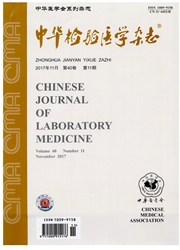

 中文摘要:
中文摘要:
目的基于色谱质谱技术深入分析北京地区青年人群和中老年人维生素D营养状态。方法现状调查。2013年5月至9月征集北京地区表观健康青年人287名(男143名,女144名),平均年龄(32.2±6.9)岁(19~44岁),198名45岁以上的表观健康中老年人[男90名,女108名,(55.6±7.6)岁],采集空腹静脉血清,使用液相色谱串联质谱法测定25羟维生素D(25OHD:25OHD2和25OHD3),以国际标准判定维生素D营养状态:25OHD〈20 ng/ml,20~30 ng/ml,30~150 ng/ml, 〉150 ng/ml分别为维生素D缺乏、不足、充足和中毒,分析该研究人群的维生素D营养状况。血清ALT、钙(Ca)、磷(P)、肌酐(Cr)、血糖(Glu)、甘油三酯(TG)、胆固醇(TC)及全段甲状旁腺激素(iPTH)采用自动化分析仪检测。25OHD使用中位数(四分位数)表示。使用SPSS 17.0进行统计学分析,比较不同年龄、性别之间差异采用非参数检验(Mann-Whitney U)。结果表观健康青年人群中25OHD水平[16.0 (6.1~29.0 ng/ml)],稍高于中老年人群,但差异无统计学意义(Z=-1.055, P〉0.05),其中男青年维生素D水平为17.9(8.3~32.3) ng/ml,女青年为14.4(5.4~26.4) ng/ml,男性高于女性(Z=-4.24, P〈0.01)。青年人群中维生素D不足、缺乏和充足率分别为:72.8%、25.1%、2.1%;中老年人群分别为:76.3%、21.2%、2.5%;男青年中分别为65.0%、30.8%、4.2%;女青年中分别为80.6%、19.4%、0%,女性维生素D缺乏率高于男性(χ2 =31.77,P〈0.01)。控制性别、年龄和BMI后偏相关分析显示25OHD与Cr呈显著正相关(相关系数r=0.221,P〈0.01),与iPTH呈显著负相关(r=-0.264, P〈0.01)。结论北京地区表观健康青年人群及中老年人中均普遍存在维生素D缺乏,且青年女性缺乏率显著高于男性。
 英文摘要:
英文摘要:
ObjectiveTo analyze the vitamin D status among apparently healthy younger and elder adults in Beijing based on liquid chromatography tandem mass spectrometry.MethodsThis is an observational study. Participants included 287 apparently healthy young adults(143 males and 144 females) with an average of (32.2±6.9) years old(19-44 years). At the same time 198 middle- and elder-aged adults were recruited [90 males, 108 females, (55.6±7.6) years], and fasting blood samples were collected and serum were isolated. They measured 25-hydroxyvitamin D (25OHD: 25OHD2 and 25OHD3) using liquid chromatography tandem mass spectrometry method. Vitamin D with deficiency, insufficiency, sufficiency and intoxication was categorized as 25OHD 〈20 ng/ml, 20-30 ng/ml, 30-150 ng/ml, and ≥150 ng/ml, respectively. ALT, Ca, P, Cr, Glu, TG, TC and iPTH wereanalyzed using automatic analyzers.Statistical analysis was performed using SPSS17.0.ResultsThe median 25OHD level in the total studied younger adults was 16.0[2.5%-97.5%: (6.1-29.0) ng/ml] which didn′t show significant difference with that of middle- and elder-aged adults. Younger males had significant higher level of 25OHD than females [17.9(8.3-32.3) ng/ml vs. 14.4(5.4-26.4) ng/ml, Z= -4.238, P〈0.01]. Of the total younger subjects, the rate of vitamin D with deficiency (〈20 ng/ml), insufficiency (20-30 ng/ml) and sufficiency (≥30 ng/ml) was 72.8%, 25.1%, 2.1%, respectively, while that of middle- and elder-aged adults was 76.3%, 21.2%, 2.5% respectively, and that of younger males was 65.0%, 30.8%, 4.2%, respectively while that of younger females was 80.6%, 19.4%, 0%, respectively. Younger females had significantly higher rate of 25OHD deficiency (χ2=31.766, P〈0.01). With adjusting sex, age and BMI, serum iPTH (r= -0.264, P〈0.01) was significantly negatively correlated with 25OHD while Cr (r=0.221, P〈0.01) showed significantly positively correlation with 25OHD.ConclusionVitamin D deficiency is prevalent in both
 同期刊论文项目
同期刊论文项目
 同项目期刊论文
同项目期刊论文
 25OHD analogues and vacuum blood collection tubes dramatically affect the accuracy of automated immu
25OHD analogues and vacuum blood collection tubes dramatically affect the accuracy of automated immu The Measurement of High-Density Lipoprotein Mediated Cholesterol Efflux from Macrophage Cells byLiqu
The Measurement of High-Density Lipoprotein Mediated Cholesterol Efflux from Macrophage Cells byLiqu 期刊信息
期刊信息
